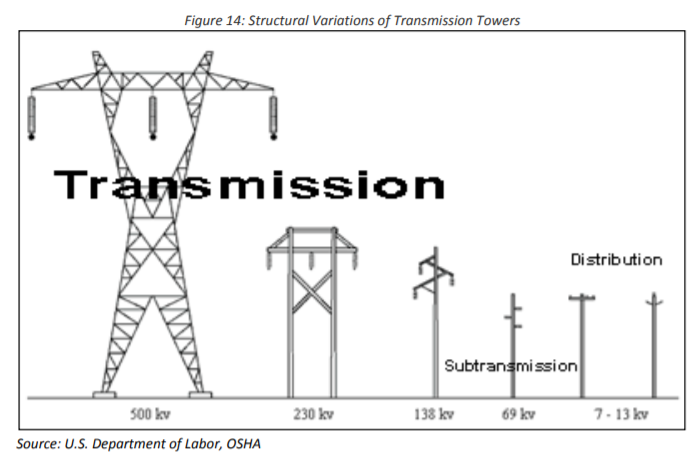Brief Notes on Power System Voltage Levels
There are a variety of voltage levels used in a typical electric power system. Some examples from the hierarchy are given below. The unit "kV" denotes a thousand volts. The specific voltage levels and practices will vary from country to country.
I have attached a link to a primer from the US Department of Energy. It has a nice graphic, which I will attach separately. Credit for the image goes to the linked source. The text below is from me, and not directly from the source document.
https://www.energy.gov/sites/prod/files/2015/12/f28/united-states-electricity-industry-primer.pdf

1) 500 kV - EHV - "Extra High Voltage Transmission" - Used for bulk transmission over long distances. This is the highest voltage you will "typically" see in North America. There is also a bit of 765 kV, but it is more rare. EHV lines travel on large lattice towers.
2) 115 kV or 230 kV - "High Voltage Transmission"
3) 69 kV - "Sub-transmission" - These are the big metal poles (usually not lattice towers) that you see running through cities. You may have a few HV lines coming into a city, and then after transformation to sub-transmission level, there will be many more of these lower voltage circuits feeding the city. There is typically a great deal of interconnection and redundancy in the sub-transmission network.
4) 12 kV - "Distribution" - This runs from your local substation (within a few km) and feeds many houses (indirectly - read on). Typically seen on a smaller wooden pole. Again, there are many more distribution circuits than there are sub-transmission circuits.
5) 240 V or 120 V - "Residential" - The 12 kV circuit is about 7200 volts line-to-neutral, whereas the 12 kV is "line to line" in the three-phase circuit. The 7200 volts is taken to one of the small transformers outside your house or on your street, where it is stepped down to 240 volts. Then the 240 volts runs your big appliances (washer, dryer, stove, etc.), and it is also split into multiple 120 volt circuits for powering other things (toaster, lights, etc.). Note that instead of 120 volts for small appliances, many countries use 220 volts.
Easy Math Editor
This discussion board is a place to discuss our Daily Challenges and the math and science related to those challenges. Explanations are more than just a solution — they should explain the steps and thinking strategies that you used to obtain the solution. Comments should further the discussion of math and science.
When posting on Brilliant:
*italics*or_italics_**bold**or__bold__paragraph 1
paragraph 2
[example link](https://brilliant.org)> This is a quote# I indented these lines # 4 spaces, and now they show # up as a code block. print "hello world"\(...\)or\[...\]to ensure proper formatting.2 \times 32^{34}a_{i-1}\frac{2}{3}\sqrt{2}\sum_{i=1}^3\sin \theta\boxed{123}Comments
@Steven Chase Yeah Good stuff. Thanks for posting.